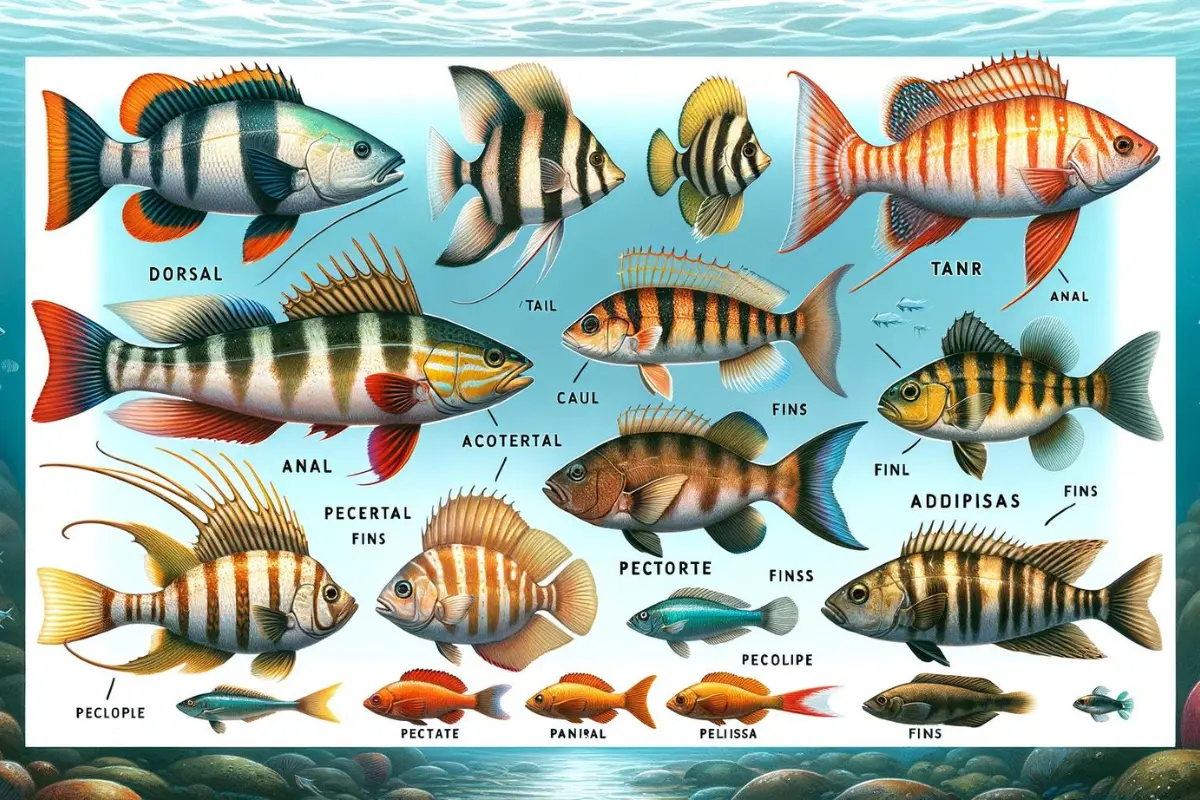Yes, like most other freshwater fishes, tilapia also has fins and scales. The fish has six fins, including a big dorsal, an anal, and a pair of pelvis and pectoral fins. They have cycloid scales distributed in 2 lateral lines.
Both fins and scales have essential roles in tilapia’s life. The fins help them to stabilize and swim efficiently underwater. They play a role in maintaining balance, navigation, and swift changes of direction.
Scales, on the other hand, serve as a protective layer on their body. It guards them against injuries and infections. Additionally, scales contribute to the fish’s buoyancy and help regulate osmotic balance and thermoregulation.
What Are the Different Types of Fins Do Tilapia Have?
Tilapia has 4 different types of fins. Each of them has a specific role to play in tilapia’s survival.
1. Dorsal Fin
While most freshwater fishes have multiple fins, tilapia has only one. The fin is large and located on the back of the body. The dorsal fin of tilapia contains no finlets. It has about 14 to 16 spines and 10 to 13 soft rays.
The presence of the dorsal fin is significant for tilapia. It helps in stabilization and maintaining balance while swimming. The other roles of dorsal fins include the following:
- The dorsal fin of tilapia, being bigger, provides more stability and hydrodynamics.
- The fin helps them take quick turns, which helps them escape predators.
- Dorsal fins also help them adapt to their aquatic environment. The fin helps them control their body temperature and adapt to the water temperature. It is crucial for their survival in different parts of the water.
2. Anal Fin
Tilapia has one anal fin located near the anal. It has 3 spines and about 7 to 9 soft rays. The spines and soft rays in the anal fin of tilapia provide structural support and flexibility. While the spines offer rigidity and prevent collapse, soft rays make them flexible for precise movements.
The anal fin helps tilapia navigate and swim efficiently. Its primary purpose is to aid in maintaining an upright position. It is essential for swimming and feeding.
The male tilapia uses its anal fin for courtship to attract female tilapia for reproduction. Moreover, the fin assists in preventing rolling or spinning motions.
3. Pectoral Fins
You will notice that tilapia fish have two fins on either side of their heads. These fins are known as pectoral fins. The benefits of having pectoral fins include:
- Higher stability during swimming
- Easy and precise movements that allow the fish to navigate efficiently
- The pectoral fins play a major role in changing directions.
- Tilapia can adjust the angle and position of their pectoral fins. It helps them maintain front balance while taking turns.
- These fins can be extended or retracted depending on the needs. By doing so, tilapia counteracts rolling motions and prevents tipping to one side.
- Sometimes, tilapia use their pectoral fins to capture small prey or pick up vegetation.
4. Pelvics Fins
Tilapia has a pair of pelvic fins positioned on the lower side of the fish near the pelvic of their bodies. They are placed behind the pectoral fins and play several important roles in tilapias’ life.
- These small size fins enhance tilapia’s stability as they provide additional support and balance in the water
- Along with the other fins, pelvics also contribute to precise movement and change direction
- Pelvic fins are also used with pectoral fins to perform courtship rituals
Importance of Scales for Tilapia
The scales in tilapia serve multiple purposes. You may find it difficult to get rid of the scales when cooking, but tilapia needs them for various reasons in their aquatic lives.

1. Protection from Predators
The primary function of scales is to protect tilapia from predators. The scales are a part of their defense mechanism against them. Their overlapping, tough scales create a strong and tough layer covering their soft body. It reduces their vulnerability against bigger fish.
2. Prevents Parasites
Parasites can affect the lives of tilapia under water. The overlapping layer of scales prevents these parasites from reaching their main skin. Thus, it saves them from skin infections and helps them lead a healthier and better life.
3. Body Temperature
The temperature of water is not the same in all parts of it. Fishes need to adjust their body temperature to live comfortably in different temperatures. Different organs help tilapia in doing so, and scales are one of them. The thermal regulation also influences their metabolism, digestion, and overall vitality.
4. Swimming
The scales of tilapia give them a streamlined alignment that helps them in swimming. The scales reduce water resistance when the fish moves through the water. It helps them swim faster and catch their prey. Besides, the reduction of dragging preserves their energy during prolonged swimming.
What Other Fishes Have Scales and Fins?
There are many other fishes with fins and scales. They are common structures among freshwater fish. Here is a list of fish with both scales and fins:
- Mackerel
- Cod
- Flounder
- Haddock
- Pollock
- Halibut
- Tuna
- Sardine
- Herring
- Pike
- Salmon
- Whitefish
- Trout
- Pickerel
FAQ
Is tilapia fish kosher?
Yes, tilapia is a kosher fish. They have both fins and scales, which are the requirements for a fish to be kosher. It makes them widely acceptable as edible fish across different cultures and religions.
Do tilapia have red fins?
Yes, some tilapia species have red fins. The coloration of tilapia fins can vary depending on the species and individual characteristics. The red fin is more common among the breeding males.
Are there any fish without scales and fins?
Yes, there are many fish species without fins and scales. The lamprey and hagfish do not have any fins, scales, or jaws. Some other fishes, like catfish, eel, etc., also do not have fins and scales.
Is tilapia a clean fish?
Yes, tilapia is a clean fish. They have a mild flavor and a first texture. The fish is raised in controlled environments that reduce the risk of contamination. However, cleanliness also depends on farming particles.
Is tilapia considered a junk fish?
No, tilapia is not a junk fish. The fish is popularly consumed in different parts of the world. They have a good taste and are easy to cook. Fishermen often intend to catch them because of their high demand.
Can I buy tilapia without a Hechsher?
Yes, you can find tilapia without a Hechsher. It is important to note that the availability of kosher-certified tilapia may vary. You should check the product labels while purchasing them if you want to adhere to kosher dietary laws.
Conclusion
Tilapia has fins and scales, and these organs are vital for their survival. Both fins and scales have specific roles to play in their lives. The simultaneous action of these organs helps them live conveniently in their aquatic environment.







